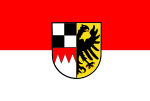Middle Franconia
This article needs additional citations for verification. (October 2006) |
Middle Franconia
Mittelfranken | |
|---|---|
 Flag  Coat of arms | |
 Map of Bavaria highlighting Middle Franconia (district) | |
| Country | Germany |
| State | Bavaria |
| Region seat | Ansbach |
| Area | |
| • Total | 7,245.70 km2 (2,797.58 sq mi) |
| Population (31 December 2020)[1] | |
| • Total | 1,775,704 |
| • Density | 250/km2 (630/sq mi) |
| Website | regierung.mittelfranken.bayern.de |
Middle Franconia (German: Mittelfranken, pronounced [ˈmɪtl̩ˌfʁaŋkn̩] (![]() listen)) is one of the three administrative regions of Franconia in Bavaria, Germany.[2] It is located in the west of Bavaria and borders the state of Baden-Württemberg. The administrative seat is Ansbach; however, the most populous city is Nuremberg.[3]
listen)) is one of the three administrative regions of Franconia in Bavaria, Germany.[2] It is located in the west of Bavaria and borders the state of Baden-Württemberg. The administrative seat is Ansbach; however, the most populous city is Nuremberg.[3]
Subdivisions[]
The region is divided into seven districts ('Landkreise') and five independent cities ('Kreisfreie Städte').[4]
Independent cities[]
Districts[]
- Ansbach
- Erlangen-Höchstadt
- Fürth
- Neustadt (Aisch)-Bad Windsheim
- Nürnberger Land
- Roth
- Weißenburg-Gunzenhausen
History[]
After the founding of the Kingdom of Bavaria the state was totally reorganised and, in 1808, divided into 15 administrative government regions (German: Regierungsbezirke (singular Regierungsbezirk)), in Bavaria called Kreise (singular: Kreis). They were created in the fashion of the French departements, quite even in size and population, and named after their main rivers.
In the following years, due to territorial changes (e. g. loss of Tyrol, addition of the Palatinate), the number of Kreise was reduced to 8. One of these was the Rezatkreis (Rezat District). In 1837 king Ludwig I of Bavaria renamed the Kreise after historical territorial names and tribes of the area. This also involved some border changes or territorial swaps. Thus the district name of Rezatkreis changed to Middle Franconia.
Main sights[]
Next to the major city Nuremberg, the capital Ansbach and the former residence city Erlangen, the towns of the Romantic Road Rothenburg ob der Tauber and Dinkelsbühl belong to the major tourist attractions. The Lichtenau Fortress, Rothenberg Fortress, Hohenstein and Cadolzburg belong to the most important castles of Middle Franconia. The Franconian Jura and the northern valley of the River Altmühl are among the scenic attractions.
Coat of arms[]
The coat of arms displays:
|
Population[]
| Year | Inhabitants |
|---|---|
| 1900 | 815,895 |
| 1910 | 930,868 |
| 1939 | 1,065,122 |
| 1950 | 1,273,030 |
| 1961 | 1,371,144 |
| 1970 | 1,486,389 |
| 1987 | 1,521,484 |
| 2002 | 1,703,869 |
| 2005 | 1,712,275 |
| 2006 | 1,712,622 |
| 2008 | 1,714,453 |
| 2010 | 1,710,876 |
| 2015 | 1,738,686 |
| 2019 | 1,775,169 |
Economy[]
The Gross domestic product (GDP) of the region was 78.6 billion € in 2018, accounting for 2.4% of German economic output. GDP per capita adjusted for purchasing power was 40,900 € or 136% of the EU27 average in the same year. The GDP per employee was 105% of the EU average.[8]
See also[]
- Upper Franconia (Oberfranken)
- Lower Franconia (Unterfranken)
References[]
- ^ "Tabellenblatt "Daten 2", Statistischer Bericht A1200C 202041 Einwohnerzahlen der Gemeinden, Kreise und Regierungsbezirke". Bayerisches Landesamt für Statistik und Datenverarbeitung (in German). June 2021.
- ^ Berg-Schlosser, Dirk (1993). Political Culture in Germany. p. 102. ISBN 978-1-349-22767-9.
- ^ "Allgerman.com - Middle Franconia (Mittelfranken)". allgerman.com. 2018-10-27.
- ^ Pressestelle, Regierung von Mittelfranken. "Regierung von Mittelfranken". www.regierung.mittelfranken.bayern.de (in German). Retrieved 2018-10-27.
- ^ County of Hohenzollern
- ^ Franconia
- ^ File:Wappen Deutscher Bund.svg
- ^ "Regional GDP per capita ranged from 30% to 263% of the EU average in 2018". Eurostat.
External links[]
- Middle Franconia
- NUTS 2 statistical regions of the European Union
- Wine regions of Germany
- Government regions of Germany